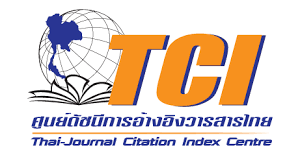ประสิทธิผลของโปรแกรมฝึกอบรมให้ความรู้เกี่ยวกับโรคพิษสุนัขบ้าของอาสาสมัครสาธารณสุขประจำหมู่บ้าน ภายใต้แนวคิด สบช.โมเดล
คำสำคัญ:
โปรแกรมฝึกอบรม, ความรู้, โรคพิษสุนัขบ้า, อาสาสมัครสาธารณสุขประจำหมู่บ้าน, สบช.โมเดลบทคัดย่อ
กลุ่มตัวอย่างเป็นอาสาสมัครสาธารณสุขประจำหมู่บ้าน จำนวน 52 คน แบ่งเป็นกลุ่มทดลองและกลุ่มควบคุม กลุ่มละ 26 คน ซึ่งได้จากการสุ่มอย่างง่ายด้วยการจับฉลากแบบไม่ใส่คืน โดยกลุ่มทดลองเข้าร่วมกิจกรรมตามโปรแกรมฝึกอบรมให้ความรู้เกี่ยวกับโรคพิษสุนัขบ้าของอาสาสมัครสาธารณสุขประจำหมู่บ้าน ภายใต้แนวคิด สบช.โมเดล ส่วนกลุ่มควบคุมดำเนินการตามปกติ เก็บรวบรวมข้อมูลด้วยแบบสอบถาม และวิเคราะห์ข้อมูลโดยใช้สถิติการแจกแจงความถี่ ร้อยละ Fisher's exact test และ Mann-Whitney U-test ผลการวิจัย พบว่า ก่อนจัดกิจกรรมตามโปรแกรมฝึกอบรมให้ความรู้เกี่ยวกับโรคพิษสุนัขบ้าของอาสาสมัครสาธารณสุขประจำหมู่บ้าน ภายใต้แนวคิด สบช.โมเดล กลุ่มทดลองและกลุ่มควบคุมมีค่าเฉลี่ยความรู้เกี่ยวกับโรคพิษสุนัขบ้าแตกต่างกัน อย่างมีนัยสำคัญทางสถิติที่ 0.05 แต่ภายหลังจัดกิจกรรมตามโปรแกรมฝึกอบรมให้ความรู้เกี่ยวกับโรคพิษสุนัขบ้าของอาสาสมัครสาธารณสุขประจำหมู่บ้าน ภายใต้แนวคิด สบช.โมเดล กลุ่มทดลองมีค่าเฉลี่ยความรู้เกี่ยวกับโรคพิษสุนัขบ้าสูงกว่าก่อนจัดกิจกรรมตามโปรแกรมฝึกอบรมให้ความรู้เกี่ยวกับโรคพิษสุนัขบ้าของอาสาสมัครสาธารณสุขประจำหมู่บ้าน ภายใต้แนวคิด สบช.โมเดล และสูงกว่ากลุ่มควบคุม อย่างมีนัยสำคัญทางสถิติที่ระดับ 0.05 แสดงให้เห็นว่าโปรแกรมฝึกอบรมให้ความรู้เกี่ยวกับโรคพิษสุนัขบ้าของอาสาสมัครสาธารณสุขประจำหมู่บ้าน ภายใต้แนวคิด สบช.โมเดล ที่พัฒนาขึ้นสามารถเปลี่ยนแปลงความรู้เกี่ยวกับโรคพิษสุนัขบ้าของอาสาสมัครสาธารณสุขประจำหมู่บ้านได้ จึงควรนำไปใช้ให้ครอบคลุมกลุ่มเป้าหมายมากยิ่งขึ้น รวมทั้งนำประยุกต์ใช้ในพื้นที่อื่น ๆ ตามความเหมาะสมต่อไป
References
Avakul, W. (1997). Training. (2nd ed.). Bangkok: Chulalongkorn University Printing House.
Bloom, B. S. J. (1965). The role of educational science in curriculum development. International Journal of the Educational Sciences, 1(1), 5-15.
Bloom, B. S. J. (1975). Taxonomy of educational objectives, handbook I: The cognitive domain. New York, NY: David McKay.
Cronbach, L. J. (1984). Essentials of psychology and education. New York, NY: McGraw-Hill.
Chulabhorn Royal Academy. (2022). Her Royal Highness Princess Chulabhorn Krom Phra Srisavangavadhana presided over the second meeting of the “Rabies-Free Animals, Safe People” project. Retrieved 20 January 2024, from https://www.chulabhornchannel.com/media-library/online-news/2022/04.
Department of Livestock Development, Department of Health Service Support, Department of Disease Control & Department of Local Administration. (2023). Memorandum of Understanding on the cooperation to develop the potential of volunteers working on rabies under the Disease-Free Animals, People Safe from Rabies project, in accordance with the wishes of Professor Dr. Her Royal Highness Princess Chulabhorn Krom Phra Srisavangavadhana. Bangkok: Department of Livestock Development.
Faul, F., Erdfelder, E., Buchner, A. & Lang, A. G. (2009). Statistical power analyses using G*Power 3.1: Tests for correlation and regression analyses. Behavior Research Methods, 41(4), 1149-1160. https://doi.org/10.3758/BRM.41.4.1149.
Hennessy, S., Bilker, W. B., Berlin, J. A. & Strom, B. L. (1999). Factors influencing the optimal control-to-case ratio in matched case-control studies. American Journal of Epidemiology, 149(2), 195-197. doi:10.1093/oxfordjournals.aje.a009786.
Kuder, G. F. & Richardson, M. W. (1937). The theory of the estimation of test reliability. Psychometrika, 2(3), 151–160.
Laosetthakij, B., & Pramuan, P. (2023). Development of rabies surveillance and prevention model using community participation in Sisaket Province. KKU Journal for Public Health Research, 16(1), 90-106.
Praboromarajchanok Institute Act B.E. 2562. (5 April 2019). Royal Thai Government Gazette, 136(43A), pp. 40-65.
Rovinelli, R. J., & Hambleton, R. K. (1977). On the use of content specialists in the assessment of criterion-referenced test item validity. Tijdschrift voor Onderwijsresearch, 2(2), 49-60.
Saenjai, A., & Sontichai, A. (2022). The effects of using Google Application on knowledge, attitudes, and behaviors regarding rabies prevention. Journal of Nursing and Health Research, 23(1), 134-144.
Tianthavorn, V. (2023). PBRI Model Concept. Nonthaburi: Praboromarajchanok Institute, Ministry of Public Health.
Thuybungchim, S., Prompukdee, B., & Sisod, K. (2021). Development of Rabies Prevention and Control Model in School located in area of positive rabies test from animal head; Mueang Phon sub district, Phon district, Khon Kaen province. Journal of the Office of DPC 7 Khon Kaen, 28(3), 93-108.
Valaisathien, J., & Unrat, B. (2022).Development of a model for enhancing health literacy to prevent and control rabies in the model area, Srinarong District, Surin Province. Journal of Office of Disease Prevention and Control 9 Nakhon Ratchasima, 28(1), 27-37.

Downloads
เผยแพร่แล้ว
How to Cite
ฉบับ
บท
License
Copyright (c) 2025 วารสารสาธารณสุขและวิทยาศาสตร์สุขภาพ

This work is licensed under a Creative Commons Attribution-NonCommercial-NoDerivatives 4.0 International License.
บทความทุกบทความที่ได้รับการตีพิมพ์ถือเป็นลิขสิทธิ์ของ วารสารสาธารณสุข














